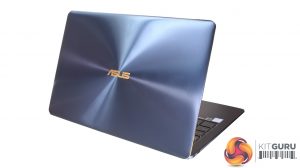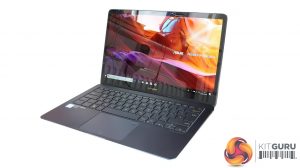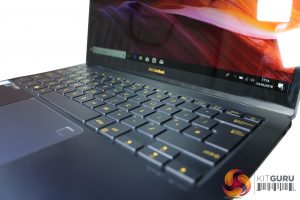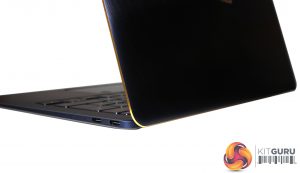Asus is keen to emphasise the work done to build this machine – no surprise when you consider the techniques used to design the Zenbook.
For starters, this notebook is hewn from a single piece of aluminium. That’s not unique among luxury laptops, but Asus has gone several steps further during the manufacturing process.
The body has a spun metal finish that’s gone through forty different processing steps – including an extra polishing stage at the end which, apparently, makes the laptop even smoother and shinier. The model we’ve reviewed comes in Asus’ Royal Blue shade, and it’s also available in a gunmetal grey.
Asus uses a dual-phase anodising process to create golden, diamond-cut edges around the Zenbook’s base and lid. It’s an attractive, eye-catching effect – many other notebooks have bezelled edges like this, but none are golden. Asus uses the same technique to create the logo on this laptop’s lid.
The slick manufacturing techniques and smart design combine to create a stunning laptop. The golden logo, subtle circular pattern on the lid and the slim metal base all look fantastic.
The Razer Blade Stealth doesn't have those golden edges, and the HP Envy x360 is clunkier and a little plasticky. In fact, the last laptop to come close was the previous generation of Zenbook, which married the same design with older components.
Asus pairs the excellent design with impressive dimensions. The Zenbook is 12.9mm thin and weighs 1.1kg – the firm even designed a new type of hinge to keep the size down. On the inside, the cooling system occupies just 0.3mm of height – with copper heatpipes with walls that are just 0.1mm thick.
Those figures mean the Zenbook undercuts the Razer Blade Stealth by a couple of hundred grams. It’s also half as chunky as the HP Envy.
Bizarrely, though, this latest generation of Zenbook is actually a little larger than its predecessor – the older machine weighed a measly 910g and was 11.9mm thick. We can only presume that the updated Zenbook is a little bigger because there’s more tech inside – and it’s not an increase that you’ll ever notice in day-to-day use.
The Asus’ main power socket is a USB 3.1 Type-C connector, and the machine is also equipped with two Thunderbolt 3/USB 3.1 Type-C connectors for charging and display output.
There’s also a headphone jack on the machine, but that’s it for native ports. If you want a full-size USB socket or an HDMI output, you’ll need to rely on the adapter that Asus includes in the box.
The final bit of pizazz is the fingerprint sensor that’s installed in the top-right corner of the trackpad. This is used for Windows Hello, and it worked well in our tests.
There’s a lot to like about this machine – but the tiny, slim Zenbook is also missing a few features. There’s no Ethernet, even on the adapter, and this system has Bluetooth 4.1, so it misses out on the minor updates of Bluetooth 4.2. You may want more ports, too – even the adapter only has one full-size USB socket.
 KitGuru KitGuru.net – Tech News | Hardware News | Hardware Reviews | IOS | Mobile | Gaming | Graphics Cards
KitGuru KitGuru.net – Tech News | Hardware News | Hardware Reviews | IOS | Mobile | Gaming | Graphics Cards






